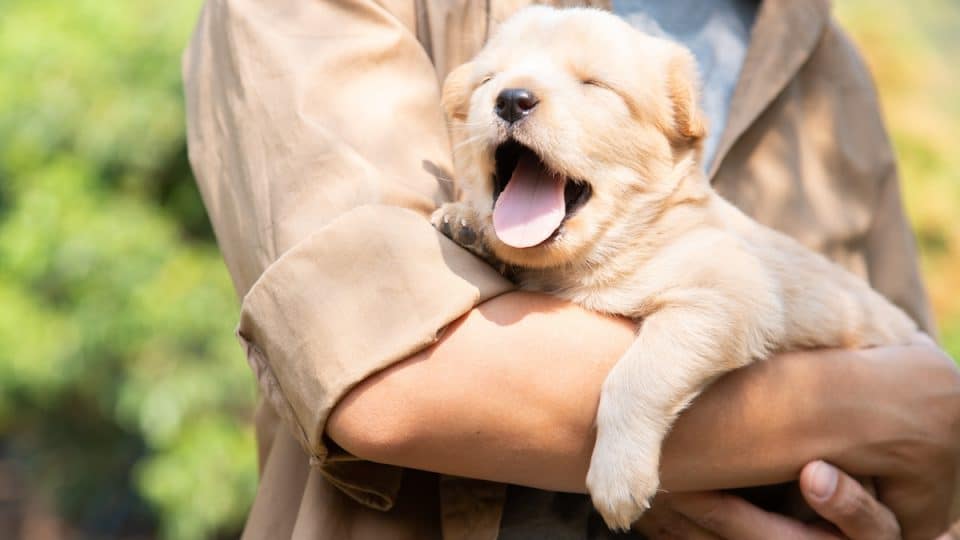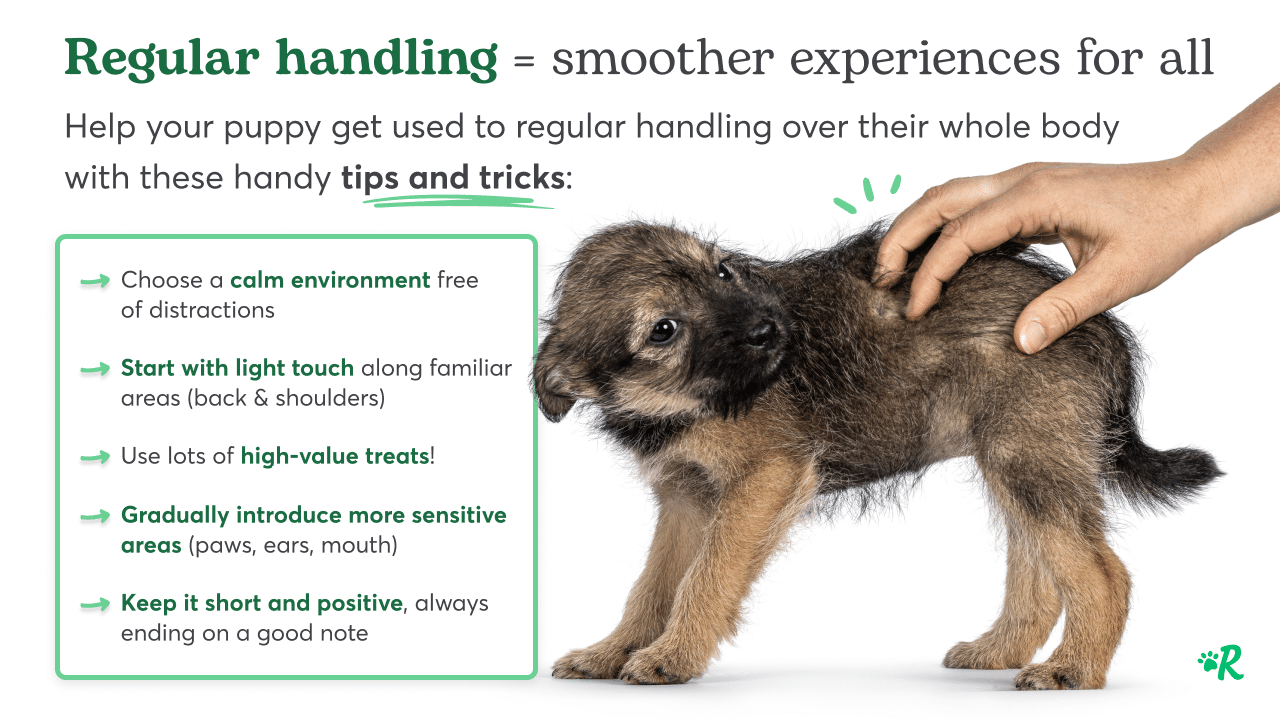- Not a substitute for professional veterinary help.
Even experienced pet parents may feel anxious about holding a puppy. Full of energy and spunk, puppies are wiggly—while also being fragile, squishy, and slippery.
To find out best practices for holding puppies of all ages, we spoke with Dr. Joanne Fernandez-Lopez, a veterinarian and veterinary advisor for breeders. She explains that it’s important to be calm and confident when holding a puppy, but not intimidating, since your approach will help a puppy feel secure. Here’s how to do it right.
How To Pick Up a Puppy
When you pick up and hold a puppy, the goal is to make them feel safe and secure while supporting their body appropriately. Dr. Fernandez-Lopez recommends the following.
- Calmly but confidently approach the puppy, then kneel or squat so you are at their level.
- Place one hand just behind the front legs while gently cradling the puppy’s hindquarters with the other.
- As you pick up the puppy off the ground, pull them gently into your body. That will help to make your puppy feel secure, prevent any unnecessary strain on their body, and enable you to keep them safe if they begin to squirm or wiggle.
Puppy Handling Guidelines by Age
Your strategy for picking up a puppy should always include staying calm and confident and distributing their weight evenly, but Dr. Fernandez-Lopez has some tips for the various ages and stages of puppyhood.
| Puppy Age | Safe Technique |
| Newborn | Puppies at this age don’t yet have mature immune systems. If a mother dog is able to care for her puppies, humans should not handle them until they are about three weeks old. Holding newborn puppies can expose them to illnesses and take them away from their source of body warmth—their mother and littermates. |
| After 3-4 weeks | It’s critical to have safe and comfortable interactions with puppies during this early stage of socialization. Touch your puppy with soft, gentle movements and hold them to your body for warmth and comfort. Always support their full body and sit while holding them to minimize risk of falls. Start small, keeping handling periods short. |
| After 2 months | At this stage, your puppy should be used to being handled and held, and you can start to incorporate being held into their daily routine. Pay extra attention to supporting your puppy’s weight with your hands, arms, and body as you carry them, particularly as they get larger and more energetic. |
Puppy Handling Guidelines by Breed
Because dog breeds differ in size, temperament, and physical needs, you may have to slightly alter your strategy based on your puppy’s characteristics.
| Breed Size | Handling Guidelines |
| Toy Size (such as Chihuahua or Toy Poodle) | These puppies can be among the most fragile and may require extra care and caution. Be gentle while supporting your puppy’s entire body, taking care to not put unnecessary weight on any one spot. |
| Large or Giant Breed (such as German Shepherd or Great Dane) | Large dogs may need more support because of their size. When lifting these breeds, always use both hands to support them, and sure that their weight is evenly distributed across your hands (holding their chest and hindquarters). |
| Active Breeds (such as Labradors or Australian Shepherds) | Be sure to use a firm but not overpowering grip. Because these breeds can be excessively squirmy, you want to make sure you have good and safe control before you stand up while holding them, or before you carry them from room to room. |
How Not To Pick Up a Puppy
Puppies, though rambunctious, are still quite delicate. Because of this, it’s very important to handle them carefully. Here’s what Dr. Fernandez-Lopez tells pet parents not to do when picking up a puppy.
- Don’t startle a puppy. That can create negative associations with handling—so it’s best to make sure your puppy sees you coming.
- Don’t pick up your puppy by the legs. Picking up a puppy by their legs (front or back) can cause damage to their bones, joints, and ligaments.
- Don’t pick up puppies by their scruff. While mother dogs may pick up their very young pups by the scruff, pet parents should not. This can be painful to your puppy, and if they’re a large breed, it can also be dangerous.
- Never grab a puppy by the tail. While this may seem obvious, your puppy’s tail cannot support their weight, and you can cause lifelong damage.
- Never release a puppy while you are standing. Instead, gently place your puppy back on the ground. They should not be allowed to jump from your arms while you are standing. If you feel you might drop a squirming puppy, quickly kneel to the ground so that they don’t fall if you lose your hold.
How To Teach Children to Pick Up a Puppy

playb via iStock
Children and puppies may go hand in paw, but young children will need assistance learning to hold puppies correctly. Just like adults, they should be calm when they hold a puppy. If a child is afraid of dogs, try having them start with just petting until they are more comfortable. If the child is experiencing stress, they may pass that on to the puppy.
It’s best for children to kneel or sit while learning to hold a puppy. This is for the safety of both the puppy and the child. Model the right way to hold a puppy (supporting their chest and hindquarters), then carefully pass the puppy to the child, keeping your hands in the right position as the child pulls the puppy close into their chest.
Keep your hands on the puppy until you are sure that the child can support the puppy on their own. Offer words of support and praise for both the puppy and the child. Always monitor children as they hold puppies, and be sure that they understand the importance of following the rules.
What If My Puppy Doesn’t Want to Be Held?
Sometimes, your puppy might not be interested in being held. A puppy who doesn’t want to be held may squirm, whine, or attempt to free themselves. While occasionally your puppy’s protest just means you’re interrupting an activity they were enjoying, other times it can indicate that your puppy isn’t comfortable.
If you’ve checked your technique and it’s calm, gentle, and supportive, it’s possible your puppy simply doesn’t like being held—not all puppies do.
In that case, your goal might shift from cuddle time to gentle sessions of handling training, which is a good socialization practice that creates positive associations around petting and holds.
How To Socialize a Puppy To Be Held
Because the experiences that a young puppy has with humans and with being held can leave a lasting impression, Dr. Fernandez-Lopez recommends that pet parents take a slow, calm, and routine approach to socializing their puppies to touch.
One of the best things to practice with your puppy is gentle restraint, like they’ll receive at the vet when it’s time for shots, blood draws, or sometimes nail trims. When practicing:
- Sit on the ground at their level, then slowly pick them up, supporting them well with both hands and your own body
- Speak softly but confidently
- Offer lots of treats
- Keep sessions short and end on a high note, while your puppy is still calm
- Watch your puppy’s body language for signs of stress—if you see these, stop and try again later
Establishing a routine for holding your puppy can help them adapt to the experience and set a foundation that helps them feel good about handling for the rest of their life.
FAQs
Does holding a puppy help to calm them down?
According to Dr. Fernandez-Lopez, for many puppies, holding can have a calming effect. Physical contact can feel safe and secure. In time, puppies will recognize the smell of their humans and associate it with positive experiences. Also, puppies benefit from feeling your heartbeat and sharing your body warmth.
How do I suddenly pick up a puppy if I need to?
If you are in a situation where you must pick up a puppy suddenly for safety reasons, do your best to be calm but confident. Grip them under their chest and under their hindquarters, and hold them firmly to your chest to create a secure hold while you move them to a safer location. Use soothing words to encourage them, and give them praise after you put them back down.
Why can a mother dog pick up a puppy by their scruff when humans should not?
Mother dogs naturally know how to pick up their puppies by their scruff, but humans just don’t have this instinct. We are more likely to cause puppies pain or to physically hurt them if we pick them up by their scruff.
Why can’t I hold a newborn puppy?
Newborn puppies need the warmth of their mother and littermates and do not have mature immune systems. If a mother dog is able to care for her puppies, humans should wait until the puppy is about three weeks old before beginning to handle and hold them. This also helps to prevent passing any illness to a puppy.





